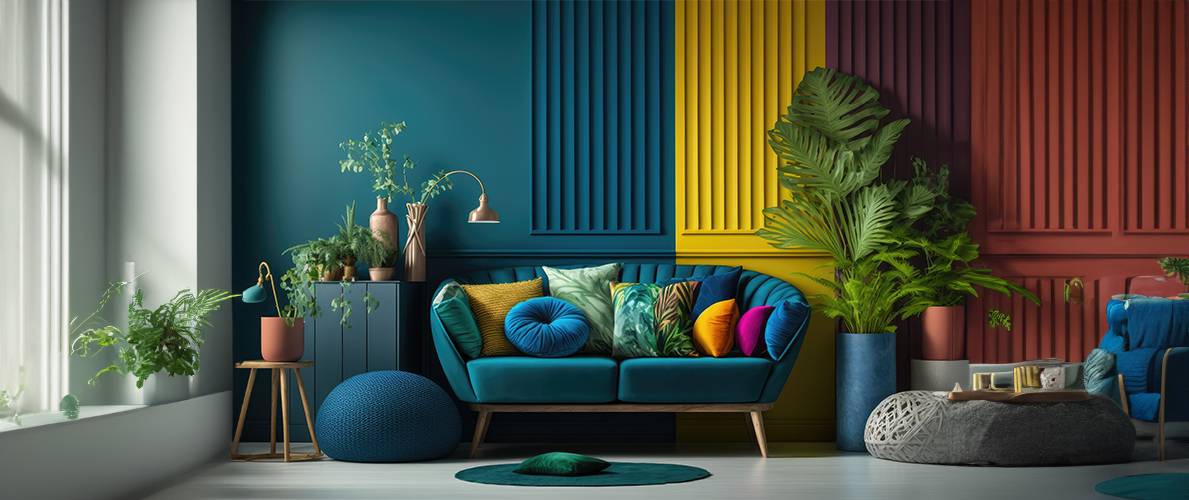Change Your Home With Important Concepts of Interior Layout and Aesthetic Appeals
The art of changing your home through the important concepts of interior decoration and aesthetics needs a thoughtful technique that balances color, balance, and spatial recognition. By recognizing the effect of shade concept and the importance of structure and patterns, one can create areas that are not just aesthetically attractive but additionally deeply individual. Accomplishing this equilibrium entails more than simple design; it includes a strategic setup and an eager understanding of exactly how each component communicates within an area. As we check out these foundational principles, think about how they may redefine your understanding of home and individual expression.
Comprehending Color Theory
Shade theory is a basic aspect of interior decoration that considerably affects state of mind, understanding, and overall visual. Understanding the principles of shade theory enables developers to produce spaces that reverberate emotionally with passengers while fulfilling useful requirements (Architecture Firm). Colors can be classified into 3 key kinds: key, secondary, and tertiary. Each classification plays a crucial duty in developing harmony within a room.
The psychological effect of colors is extensive; warm tones such as reds and oranges evoke energy and heat, while great tones like blues and eco-friendlies promote peace and serenity. The use of complementary shades improves visual rate of interest, producing striking contrasts that can boost a space's charm.
Neutral shades, on the other hand, function as a flexible backdrop, permitting various other layout aspects to radiate. It is important to consider factors such as lights and the room's purpose when selecting a shade scheme, as these can change the assumption of shades throughout the day.
Ultimately, a well-considered color pattern can transform a space, fostering a feeling of convenience and design that lines up with the inhabitants' choices. Mastery of shade theory is, consequently, an essential ability for any indoor developer intending to produce unified and welcoming environments.
Achieving Equilibrium in Layout
Just how can designers attain a feeling of balance in their spaces? Achieving equilibrium in design is basic to developing unified interiors.
Unbalanced equilibrium, on the various other hand, depends on differing elements that still attain a natural appearance. This approach enables for even more vibrant and casual arrangements, offering rate of interest while preserving equilibrium. By meticulously picking varying dimensions, shades, and appearances, designers can develop an aesthetically compelling space that feels well balanced yet energetic.
Radial equilibrium highlights a main focal point with aspects radiating exterior. This design is frequently seen in circular designs, where furnishings and decor develop a natural surround that draws the eye internal.
Ultimately, achieving balance needs thoughtful consideration of scale, proportion, and the connections between components. Architecture Firm. By skillfully using these equilibrium principles, designers can change spaces into settings that really feel both cosmetically pleasing and functionally harmonious, boosting the total experience for passengers
Relevance of Spatial Awareness

A keen sense of spatial awareness enables developers to determine focal points within a space, directing the audience's interest to essential functions while keeping a general feeling of unity. It likewise assists in the critical positioning of lights, which can significantly affect the understanding of space and state of mind. Understanding spatial connections makes it possible for the developer to provide to the particular needs of citizens, making certain that each area offers its desired function without jeopardizing visual appeals.
Ultimately, spatial recognition is vital for maximizing the possibility of any kind of indoor room. By thoroughly considering the interaction between measurements, design, and feature, designers can develop atmospheres that not just satisfy useful demands yet also stimulate a sense of comfort and elegance, enhancing the general living experience.
Incorporating Appearance and Patterns
Welcoming a varied variety of structures and patterns can substantially boost the visual and responsive allure of an indoor space. The critical use of various materials-- such as wood, metal, textile, and rock-- produces deepness and passion, making a space feel more inviting and dynamic. Combining smooth surfaces with rough appearances can establish a balance that attracts the eye and involves the senses.
When incorporating patterns, take into consideration both scale and repetition. Large patterns can offer as prime focus, while smaller, refined designs can enhance various other components without frustrating the space. Layering patterns, such as pairing floral cushions with striped throws, includes complexity and a feeling of harmony if performed thoughtfully.
It is also essential to preserve a natural color scheme, ensuring that appearances and patterns straight from the source interact instead of compete for interest. By picking a few key structures and patterns, you can create a merged aesthetic that reflects your personal design while enhancing the overall ambiance of the room. Ultimately, the cautious unification of these components can transform an ordinary click here for more info area into an innovative atmosphere rich with personality and warmth.
Individualizing Your Area
Creating a space that reflects your character is vital to attaining an absolutely welcoming atmosphere. Personalization in indoor layout enables you to infuse your one-of-a-kind style and passions right into your home, changing it from a simple shelter into a sanctuary that talks with who you are. Begin by picking a color combination that resonates with your emotions-- vibrant colors can invigorate, while soft tones supply harmony.
Incorporate art work and decoration that mirror your interests, whether it be traveling, nature, or abstract principles. Displaying individual collections, such as publications, photographs, or souvenirs, can stimulate valued memories and create centerpieces within an area. Furthermore, consider personalizing practical pieces, like upholstered furnishings, to straighten with your visual choices.

Conclusion
To conclude, the change of a home with the necessary concepts of interior decoration and visual appeal necessitates a comprehensive understanding of shade concept, balance, spatial understanding, structure, and customization. Each component adds significantly to creating an unified and functional living environment - miami interior design. By attentively incorporating these concepts, individuals can boost the aesthetic charm and psychological vibration of their spaces, ultimately promoting a home that shows one-of-a-kind identifications while supplying comfort and practicality